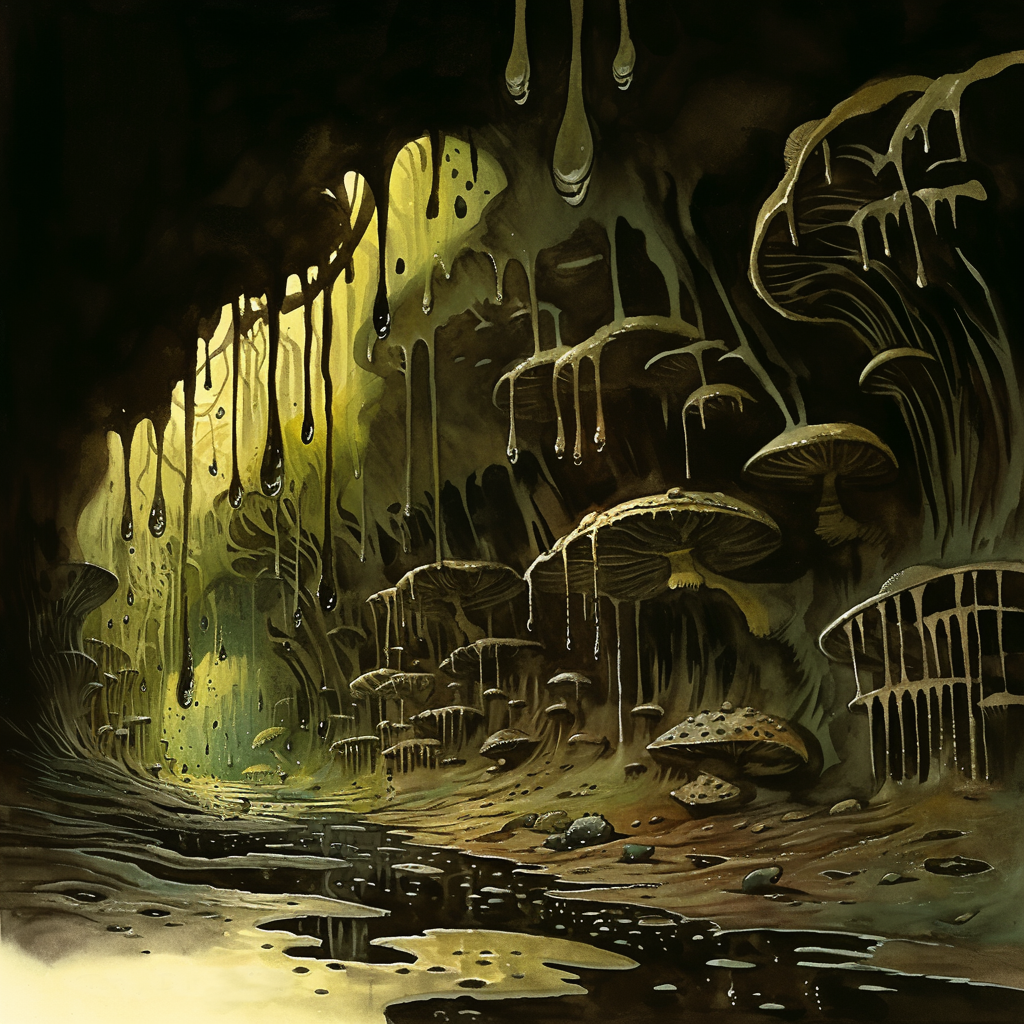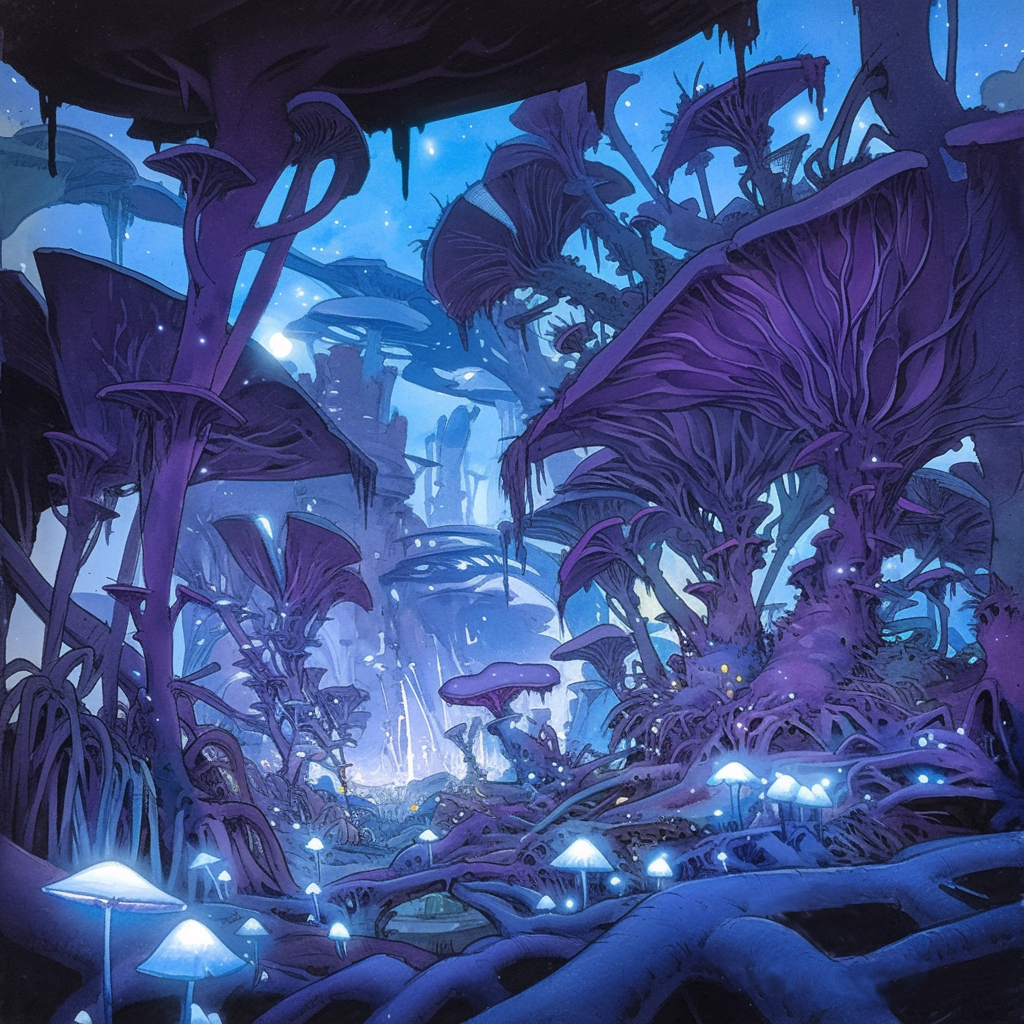Mythenosca

If Mycelia is Psilofyr’s sacred grove, untouched and serene, then Mythenosca is its pulsing, alien heart—a sprawling fungal hive teeming with life, industry, and strange customs. Unlike the tranquil vastness of the cavern’ proper, Mythenosca is an intricate tangle of fungal architecture, glowing spore-traffic, and myconid society operating at a rhythm that is largely incomprehensible to outsiders.
Nestled along cavern walls and stretching downward into organic fissures, Mythenosca’s structures are grown, not built. Towering mushrooms double as homes and workplaces, their caps glistening with dew. Bridges made of mycelial threads stretch between spires, pulsating gently as nutrients flow through them. Bioluminescent lichen forms patchwork mosaics across the walls, shifting in colour and intensity to signal messages to those who can interpret the subtle fungal language of light.
Navigating Mythenosca is an alien experience for meat-folk. The streets aren’t streets at all but glowing trails of mycelium that respond to touch and thought. These Glowpaths shift and spiral, rerouting visitors based on their intentions or the whims of the city’s subconscious will. To a cutter who lacks patience, it’s chaos; but to a myconid, it’s perfect order, a living map that always leads where one needs to be—even if that’s not where one wants to go.
The burg’s buildings draw in air and exhale spores, creating a rhythmic breeze that permeates the entire city. Entering one of these fungal dwellings means stepping into a living entity. Walls pulse, adjust, and even grow furniture in response to each visitor’s needs. Inns grow soft beds of warm, springy moss for meat-folk guests, while marketplaces sprout racks and shelves to display their wares.
Mythenosca isn’t horizontal like most prime burgs—it’s a labyrinth of vertical layers. Higher levels, perched on vast fungal stalagmites, house the city’s thinkers and decision-makers. The middle tiers bustle with workers processing rare spore derivatives, fermenting potions and distilling elixirs. At the base, deep in the damp gloom, the Shaded Warrens hum with the activity of the myconid masses in the fungal gardens. Communication here is a chorus of thought-vibrations and colour changes, a sensory symphony incomprehensible to anyone without a mind attuned to the fungal gestalt.
Life Among the Spores
Instead of coin or barter, the economy of Mythenosca revolves around spores. Everything of value is tied to a spore type: there are glowing healing spores, shimmering hallucination spores, and chameleonic spores that bind minds together for collaborative projects. Sporespinners—myconid artisans who cultivate and modify these spores—are the burg’s true elites. They dwell in massive hollow mushrooms, working to perfect strains that are more valuable than gold for their psychic properties.
Time in Mythenosca isn’t measured in seconds or bells but in cycles of fungal growth. “When the lichen on the Central Spire turns crimson” is as precise as an hour to a myconid. Meanwhile, conversations between the citizens flow not as spoken words but through shared thoughts—so-called thoughtstreams that ripple through the mycelial network. Visitors who linger in the city too long may find their own thoughts drawn into these streams too, swept along like leaves in a river.

Life in Mythenosca is built on Psilofyr’s paradoxical philosophy: absolute harmony through decentralised individuality. Each myconid is both entirely independent and fully integrated into the fungal gestalt. A worker tending to glowpaths doesn’t need orders; their task is an instinct, for they are part of the greater purpose of Mythenosca. Conflict between myconids is unthinkable here—those who harbour violent or selfish intentions find their thoughts consumed by the gestalt, gently redirected until they forget why they were angry.
Yet all this harmony is alien to outsiders. What seems like unity to a myconid can feel suffocating to humanoids. The ever-present spores, the constant mind-links, the shifting architecture—all of it erodes the boundaries of individuality. Visitors who stay too long sometimes report dreams of nebulous roots growing through their minds, a sign they are becoming part of Mythenosca’s network in ways they can’t control.
Beneath the bustling upper city lies the Undergleam, a network of shadowy tunnels where the laws of the Circle of Nine feel weaker. Here, rogue myconids experiment with forbidden spore strains and even more alien ideas—crossbreeding fungal life with living magical constructs. Some whisper of hybrid spores that can bind modrons or raise the dead, creations Psilofyr would never condone. The Undergleam hums with whispered warnings of Velth’s poison and the dangerous influence of outcasts like the Somnalith.

In the city’s heart lies the Violet Expanse, a massive fungal garden tended by the entire community. Here, rare mushrooms bloom in mesmerising fractals, each species releasing spores with psychic effects. Some inspire visions of other planes; others heal, revive or invigorate. The Expanse is simultaneously a temple, a farm and a laboratory—a place where Psilofyr’s philosophy is cultivated in living form.
At the edge of the burg you can find the Fruiting Palace, a temple to and home of Psilofyr itself. The high-ups of Mycelia, strange interconnected fungal bloods called the Circle of Nine also hold council here.
Mythenosca has more than its fair share of gates, but they never stay in the same place for long. They have a habit of sprouting from the cavern walls at intervals dictated by the gestalt’s collective will. If the city decides a visitor is unworthy or dangerous, a gate will form near them, making expulsion into Mechanus’s endless gears a simple matter of giving them a good shove. Other gates can grow to connect Mycelia with myconid colonies across the multiverse, or join with planar pathways like the Infinite Staircase.
For the daring or the curious, Mythenosca offers wonders unavailable elsewhere in the multiverse. Its markets overflow with rare fungal goods: spores that enhance or awaken psionic powers, inks for magical tattoos, even entire colonies of symbiotic fungi that bond with their hosts to grant strange abilities. Yet the price isn’t always coin—sometimes, the myconids demand memories, emotions, or dreams as payment.
Canonical Sources: Tales from the Infinite Staircase [2e] p19. Canonwatch: Mythenosca is mentioned briefly but few details are given beyond it bein g a burg in Mechanus. I decided it fitted best as a realm town of Mycelia.
Source: Jon Winter-Holt


